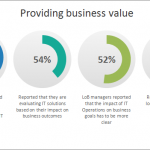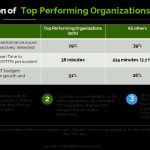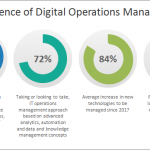Digital Enterprise Journal (DEJ) recently published a benchmark study on managing IT Operations which provides insight into the key drivers for modernization in this market and the best practices for addressing top management challenges. More than 900 organizations participated in this research and 31% of participants included non-IT users or C-level executives (Line-of-Business owners, digitalization leaders, etc.). The study provides a deep dive into the key dynamics of the market for managing IT Operations, but the purpose of this article is to answer the “so what?” question for business and IT executives and digital transformation leaders.
Fifty-two percent of business executives in the study reported that the impact of IT Operations on key business goals needs to be more clear, while 57% of organizations are looking to make IT more strategic. Most importantly, the #1 area where business executives (74% of them) are looking for IT Operations to contribute is to help improve an organization’s competitive position. So, what can IT Operations do to be a part of executive discussions around using technology as a competitive advantage?
DEJ identified 8 key areas where business executives expect IT Operations to contribute to their digital transformation and modernization strategies.
1 – Validating technology investments. Sixty-one percent of organizations are looking to use technology as a competitive advantage while another 57% are expecting new technology investments to result in revenue increase. Ensuring that new applications and digital services are not experiencing outages and latency issues is definitely important for business executives. However, digital leaders are starting to look at availability and speed of these services as more of a norm and they are expecting IT Operations to answer the bigger question – 1) are these new technologies really being used by employees, customers and partners? If not, is that related to a lack of training, user’s perception of their value or performance of these digital services and applications?
Digital transformation leaders are not interested in seeing charts from the IT that are showing all the lights are green while they are seeing that their investments in technology are not producing business value. They are looking for answers as to why that is the case and the only metrics that they care about are those that are coming from the end-user’s perspective. However, 71% of organizations in DEJ’s research reported that the metrics that IT is providing do not reflect a true user experience. On the other hand, the research also shows that top performing organizations (top 20% of research participants based on their performance in managing IT Operations) are 2.2 times more likely to have the ability to monitor user experience at the point of interaction with digital service. As a result, top performing organizations (TPOs) are able to proactively detect 79% of performance issues, as compared to 39% for all others.
2 – Remove risk from modernization and transformation strategies. Findings from DEJ’s upcoming study on Managing IT Performance for Dynamic Environments show that organizations are increasingly deploying different types of cloud (hybrid, native, multi-cloud, etc.) services, microservices and containers, as well as adopting CI/CD and DevOps environments to use technology as a source of competitive advantage and innovation. The research also shows that these organizations are finding that legacy tools are not effective in these environments. As business and IT executives are investing in these technologies to transform and modernize their processes, they are looking for IT Operations to also modernize and transform so they can reduce the business risk of these projects. DEJ’s research shows that 73% of solutions that were being used on premise are not as effective in cloud environments. Also, 61% of organizations reported that performance of microservices is significantly better in pre-production than in production. IT Operations teams need to prove their expertise in managing these emerging types of environments and ensure that these transformation projects can be conducted without deterioration in the performance of IT services.
3 – New productivity enablement. Improving productivity has been one of the core areas of business value proposition of solutions for managing IT performance, but DEJ’s research shows that the definition of productivity (as related to performance of IT services) has changed over the last 5 years. The traditional business value points of IT that: 1) employees will be less productive if applications and IT services are down or slow; and 2) IT staff is less productive if they have to troubleshoot performance issues instead of focusing of tasks that can create business value, have changed. This approach was predominantly based on focusing on uptime, latency and firefighting while digital transformation leaders are looking for: 1) IT services not only to be readily available, but to be delivered in a fashion that will lead to higher levels of employee engagement and satisfaction; 2) enabling IT Operations teams to prevent performance issues before they impact end-users.
4 – Pinpointing where the problem is. Most of IT performance management solutions are effective in providing visibility into domains that they are designed to monitor, but they are lacking the holistic picture of how entire business services are performing. When experiencing issues with performance of business services, executives are not interested in hearing what isn’t the cause of the problem, but what exactly is causing service degradations and how it can be fixed. Having a single view into an entire IT environment and visibility into full IT monitoring stack that is presented in the business context is a type of capability that business executive and digital transformation leaders are looking for when executing on their strategies for using technology to deliver business value.
5 – Unified view into IT and business performance. DEJ’s research shows that 74% of organizations are not able to quantify the impact that IT Operations has on the business goals. However, that number drops to 29% when analyzing only TPOs. These organizations are 68% more likely to have the ability to correlate IT and business metrics and, as a result, they are 66% less likely to experience revenue impacting performance incidents. Having the ability to understand the direct impact of changes in IT performance on business areas, such as conversions, employee engagement and experience and customer journey, makes IT Operations solutions much more appealing to IT and business executives and allows them to become an important part of digital transformation strategies.
6 – Business insight that you can’t get from other tools. Modern solutions for managing IT Operations are able to pull the data from a variety of sources (machine, network, systems data, etc.). This rich IT data, if properly processed and analyzed, can be effectively used to streamline business processes and provide operational intelligence in areas that are not a part of IT. TPOs are 2.6 times likely to be ensuring that multiple job roles and departments gain value from IT data and 2.7 times more likely to be leveraging a single platform for IT, Dev, Security, IoT and Business Operations. This not to say that this type of information can replace other business-centric solutions that are providing visibility into key business areas (customer experience, business intelligence, etc.), but business insights from IT data can effectively complement these solutions and provide unique insight into key areas that are critical for achieving business goals.
7 – Speed and agility. One of the key goals of digital transformation projects is to improve organizations’ responsiveness to new dynamics in their fast changing markets. DEJ’s research shows that TPOs are 74% more likely to have capabilities for real-time analysis of streaming data. Additionally, DEJ’s research shows that these organizations are 75% more likely to be taking a management approach based on advanced analytics, automation and data and knowledge management concepts. The research also shows that AI-enabled management concepts are cutting across all key attributes of modern IT Operations. Solutions that are built around concepts such as automation, AI, advanced analytics, knowledge management and collaboration and are able to process streaming data in real-time and put it into an actionable context are well aligned with the goals of organizations that are looking to improve agility and flexibility and advance their competitive position.
8 – Ease of use and time to value. Digital transformation leaders are reporting that cultural changes, inability to attract the right talent and new skill sets required are some of the key obstacles for turning their organizations into digital businesses. Therefore, the last thing that they want to hear concerning solutions for managing IT Operations is that they need to hire more data scientists to operate these solutions or that they need to invest months in training their IT staff to maximize the value of their investments. Modernizing IT Operations does require IT staff to be educated on new skills, especially around AIOps, but the easier the solution is to deploy and manage and the faster it can demonstrate the value, will be more appealing to IT and business executives.
Summary
The research reveals some staggering numbers in terms of business impact due to failures to properly manage IT Operations. Organizations are reporting $126,000 of revenue lost per one hour of IT service down time and $2,129,000 average estimated revenue loss, per month, due to performance related slowdowns in application release times. Even though these numbers show that there is a high price to pay for not modernizing IT Operations, the price of transformation and modernization projects potentially failing is much higher.
IT and business executives and digital transformation leaders have already carved out a very significant role for IT Operations solutions in their strategies. The key for successfully playing that role is being able to answer that “so what?” question and ensuring that capabilities provided are aligned with key goals of digital transformation leaders.



